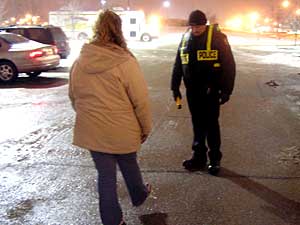|
Audio
Photos
More from MPR
Resources
|
July 29, 2005
Minnesota's drunk driving law is about to get more strict. On Monday, police can start charging people who have a .08 percent blood alcohol content, down from the current level of .10. Supporters say the change will make Minnesota roads safer. But tavern owners say when you add the lower DWI limit to smoking bans and a higher minimum wage, their businesses will take a big hit.
St. Paul, Minn. — It's 10 o'clock on a Monday night, and Deputy Scott Schneider is just starting his job. Schneider works the night shift for the Minnesota State Patrol.
Schneider and his partner, Xena, a 7-year-old malamute, travel the highways of Ramsey, Chisago and Washington counties. Since he's been working the night shift, Schneider has seen a fair number of drunk drivers and alcohol-related accidents.
"Your summer months tend to be a little more active," says Schneider. "A lot of people are home from college, a lot of festivals and a lot of activities going on."
Schneider says he's arrested about 100 drunk drivers in the past year. That number is likely to increase as the legal blood alcohol limit for drunk driving drops from .10 to .08.
As Schneider drives from accident to accident, he also watches the road for impaired drivers. He sneaks up on a Ford Taurus that's swerving a bit.
"He weaved out of the left lane, weaved into the next lane over and he just about did it again," Schneider says.
Schneider pulls the driver over. She isn't drunk; she's 15 and doesn't have a driver's license. Schneider impounds the car and returns the two teenagers to their parents.
Schneider says many drunk drivers act is if they haven't driven before. They swerve from lane to lane, make sudden stops and don't have full control of their cars. A different set of troopers see those same characteristics and pull over a maroon Chevy Suburban.
On busy Interstate Highway 35E, just north of downtown St. Paul, a group of state troopers is busy searching the vehicle while a patrol officer conducts a sobriety test on the driver.
The driver is clearly impaired. He can't walk a straight line, and sways back and forth when he tries to follow the deputy's finger. The driver has a .14 percent blood alcohol level, which is well over the legal limit. He's put in handcuffs and is headed for jail.
State Patrol chief Mark Dunaski says he expects about 1,300 additional DWI convictions a year, as Minnesota becomes the last state in the nation to adopt the .08 standard. He says the new law should also send a message that people shouldn't drink and drive.
"We do want them to understand that there are consequences out there for drinking and driving in Minnesota, and after August 1, that level is going to be slightly lower," says Dunaski.
Dunaski says Wisconsin, North Dakota and South Dakota all reported a drop in deaths due to alcohol-related crashes after they adopted the .08 standard. He says he hopes the new law forces people to ride with a designated driver if they drink, or to have fewer drinks before they drive.
While law enforcement agencies have generally positive things to say about the new drunk driving standard, it's a different story for bar and tavern owners.
It's a sunny afternoon in the Minneapolis warehouse district. A few people are sitting on the patio outside of Rosen's Bar and Grill. Others choose to avoid the heat and have a drink inside.
Mike Jennings owns Rosen's and the Refuge Bar just up the street. He says he understands that .08 could make the roads safer, but he's worried he'll see fewer customers.
"Our biggest concern is that people may just say it's just not worth going out anymore. That's where we start to worry about it," Jennings says.
Jennings says bar owners from other states told him he should prepare for a 15 percent drop in business when the law takes effect. He says he and other Minneapolis bar owners are also losing business because of a smoking ban, and are worried that a scheduled minimum wage increase will also hurt profits.
"Each individual issue causes particular problems. But when you combine all three of them altogether, I don't know what's going to happen. I think it could be a huge issue," he says.
Jennings says he knew the new .08 standard was inevitable when the federal government linked highway funding to states that adopted the standard. Minnesota lost out on $16 million in highway money for not passing the law sooner.
But even with the ability to plan for the change, Jennings says he's not sure what bar owners can do to protect their business in the face of .08, the smoking ban and the higher minimum wage -- all taking effect this year.






